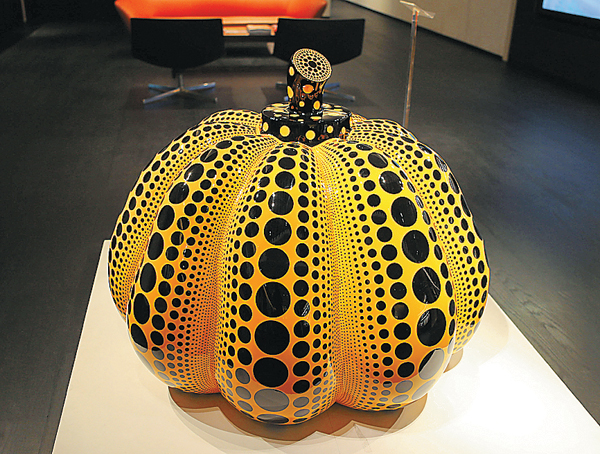Art market chills in spring
Updated: 2013-03-29 08:15
By Zhang Yuchen (China Daily)
|
||||||||
Not good enough
"The rapid exhaustion of sources (for works of art) is thought to be the main factor restricting the development of the market and it cast a gloomy aspect over everything last year," said Liu Shangyong, manager of Rongbao Auction Co in Beijing, at an annual forum held by Zhilan Yaji, a club for art collectors and dealers in December.
A shortage of good sources frustrated the auctioneers who were forced to trawl through sources in more than 10 countries in Asia and Europe in their quest for items good enough to place in their auctions, according to Liu.
 |
|
Yayoi Kusama's work was one of lots at the auction, which raised HK$47.7 million. [Photo/Xinhua] |
China's art market has witnessed wide fluctuations in the number of items and prices, hitting a peak in the 2011 spring season when the trading volume reached 42.84 billion yuan. Since then, however, the total amount of cash and the number of sales have declined.
"Awareness of the value of an art work, and the prices people are willing to pay, reflect on the country's appreciation of fine arts," said Liu Xirong, an art investor known for his collection of ancient brass pots. China's economic plan is set in a 10-year cycle, but each international cycle lasts about 20 years. That's troubling, because investment in art works is quite closely linked with the economic cycle, and people's perceptions of value double every time a piece of work is offered for resale."
While China Guardian has managed to keep its head above water, other large auction houses, such as Beijing Poly, Christie's and Sotheby's, saw their revenues fall by around one-fifth year-on-year in 2012, according to Guan.
Overall decline
The hot pursuit of contemporary art seen eight years ago has cooled. Before 2009, the best contemporary works, accumulated and stored during the preceding decades, had been sought and bought by insightful collectors, said Zhu Qian, independent contemporary art critic and curator who is based in Beijing.
Sotheby's Hong Kong suffered its darkest hour during an auction of famous contemporary Asian art when some pieces failed to meet their reserve prices, while others attracted no bids at all.
While traditional Chinese paintings and calligraphic works remain at the top of the list for treasure hunters and accounted for 50 percent of Chinese market turnover in 2012, that can't disguise the overall decline last year, when the value of almost every sector of the art market fell to about 50 percent of that seen in 2011, according to statistics provided by Artron.
A traditional piece of Chinese fine art that sold for 80 million yuan in 2009 could net a staggering 150 million yuan today, but that's only part of the picture. "Despite the rise in estimated prices, I can barely find collectors willing to sell because they have little faith or optimism in the market right now," said Dong Guoqiang, chairman of Beijing Council International Auction Co.
"A lack of confidence in the market is one of the main reasons for this low ebb," said Guan. "Confidence has been tested around the world since 2009, and the global financial crisis was not even of huge concern to the financial market in China at that time."
In years gone by, Chinese collectors paid top dollar for the best items and hung onto their purchases, rather than simply looking to immediately sell them on to auction houses in the hope of increased profit, especially at times when the market appeared highly unpredictable, said Liu Shangyong. "There are simply fewer things worth putting money into than before," he admitted.
But when considering the reasons that make collectors unwilling to sell the pieces they've accrued, people should be aware of the natural laws of the market and the way they balance out over the long term, said Dong Jun of the Forever International Auction Company Ltd, the only auction house on the Chinese mainland authorized to use the registered trademark of Christie's, the world's leading art auction house.
"That is why we have to let the market develop step by step, instead of encouraging an abnormally fast rate of growth," he said.

 Li Na on Time cover, makes influential 100 list
Li Na on Time cover, makes influential 100 list
 FBI releases photos of 2 Boston bombings suspects
FBI releases photos of 2 Boston bombings suspects
 World's wackiest hairstyles
World's wackiest hairstyles
 Sandstorms strike Northwest China
Sandstorms strike Northwest China
 Never-seen photos of Madonna on display
Never-seen photos of Madonna on display
 H7N9 outbreak linked to waterfowl migration
H7N9 outbreak linked to waterfowl migration
 Dozens feared dead in Texas plant blast
Dozens feared dead in Texas plant blast
 Venezuelan court rules out manual votes counting
Venezuelan court rules out manual votes counting
Most Viewed
Editor's Picks

|

|

|

|

|

|
Today's Top News
Boston bombing suspect reported cornered on boat
7.0-magnitude quake hits Sichuan
Cross-talk artist helps to spread the word
'Green' awareness levels drop in Beijing
Palace Museum spruces up
First couple on Time's list of most influential
H7N9 flu transmission studied
Trading channels 'need to broaden'
US Weekly

|

|







